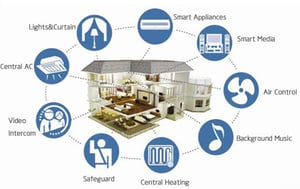 The Internet of Things (IoT) refers to the literally billions of devices vs. people that are connected to the Internet in some fashion. Rather than laptops and desktops being used by people, IOT devices are typically purpose-build devices that are performing a specific function. IoT refers to the myriad of new smart home devices like the Google Nest, Amazon’s Alexa and also your Smart TV that is connected to the Internet so you can run Netflix or Disney+ right from the TV without any set top boxes. Every one of those devices (TVs, refrigerators and other smart appliances, smart home devices like light switches, garage door openers, front door cameras, the list goes on) has an Internet address and can talk to the Internet, just like you do when you’re on your laptop or home PC surfing.
The Internet of Things (IoT) refers to the literally billions of devices vs. people that are connected to the Internet in some fashion. Rather than laptops and desktops being used by people, IOT devices are typically purpose-build devices that are performing a specific function. IoT refers to the myriad of new smart home devices like the Google Nest, Amazon’s Alexa and also your Smart TV that is connected to the Internet so you can run Netflix or Disney+ right from the TV without any set top boxes. Every one of those devices (TVs, refrigerators and other smart appliances, smart home devices like light switches, garage door openers, front door cameras, the list goes on) has an Internet address and can talk to the Internet, just like you do when you’re on your laptop or home PC surfing.
This all sounds great, but there are risks associated with these IoT devices that we have at home. Many of these IoT devices are either built with poor security or they are not properly secured as the average home user hasn’t really thought about it. Most of us just want our devices to be easy to use, and in most cases, leave the devices “open” or use an easy or default password. And if you think hackers aren’t interested in hacking your IoT devices, think again. A Zscaler report confirms that attacks on IoT devices are up 700% since 2019.
If the average household now has 10 or more connected devices, that’s 10 places where poor or non-existent security controls could provide a bad guy easy access into your home network. From a business standpoint, with so many people now working from home, someone on yours or your employee’s home network is one step away from accessing the sensitive company information on your corporate network. This person could be a family member, a guest, or a hacker who has gained access via lax controls.
So, if you are a business owner with employees working from home, what should you do to reduce your risk from IoT? Here are 5 steps you and your staff should take to secure your home network and IoT devices.
- Ensure your home router is set up correctly. That means everything from renaming the router to changing the default admin passwords. The last thing you want is for someone to find out the make and model of your router and to find a default password for it.
- Segment your home network. This is especially important for anyone working from home. You need to segment your network for family access, guest access, work, and finally a segment for all your IoT devices.
- Change default passwords on all IoT devices. Just like changing the password on the router, it is important to change the default password setting on your IoT devices.
- Update firmware regularly. Most IoT devices and home routers do not update automatically on their own. You should do a check every month or so for any new updates, particularly for security patches. Once you know that there is a new version available, ensure you patch as soon as possible.
- Use a strong password policy. This goes without saying, but if your devices password is “password123” it is useless. Use passphrases or three random words to come up with a strong password that you can remember.
IoT devices are great in that they can make our lives easier, but because they are connected to the internet, there is a risk involved. Ensure that you follow these 5 steps to help protect yourself at home, and also protect your work network. For further tips and information, visit the QuickProtect website.
